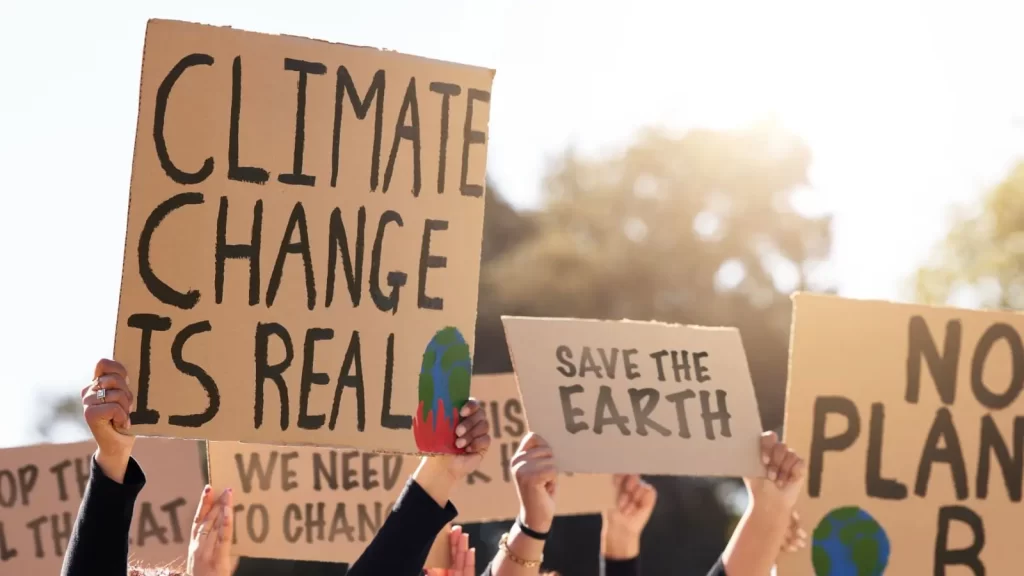Climate Change Resilience | Innovative Solutions for Sustainable Future

Table of Contents
Key Takeaways
- Earth’s Fever is an urgent metaphor for the dire state of climate change.
- Rising global temperatures have led to extreme weather events, melting ice caps, and rising sea levels.
- Urgent action is needed to mitigate the harmful impacts of climate change on human health, ecosystems, and global stability.
Introduction

Environment adjustment and climate change has become one of the most important concerns of our time, with its damaging impacts really felt across the globe.
The metaphor of “Planet’s High temperature” vividly catches the climate change urgency and intensity of the circumstance, comparing the world’s rising temperature levels to the signs of a health problem.
In this post, we delve into the damaging influences of climate change adjustment, highlighting the need for instant action to address this worldwide situation.
Short introduction of the existing state of environment adjustment
Climate adjustment describes long-term climate change in temperature level, rainfall, and other weather, mostly brought on by human activities such as melting fossil fuels and logging.
These tasks release greenhouse gases into the ambience, trapping heat and causing a stable increase in global temperature levels.
Intro to the concept of “Planet’s Fever” as an allegory for climate adjustment:
” Earth’s High temperature” works as a powerful allegory for the escalating situation of environment modification. Just as a high temperature suggests an underlying disease in the body, increasing temperatures signify the visibility of a deep-rooted trouble within our planet’s ecological communities.
Thesis statement outlining the hazardous impacts of environment adjustment and the urgency of addressing it
The harmful influences of environment climate change, from extreme climate occasions to rising water level, position substantial dangers to human well-being, biodiversity, and global security.
Urgent action is imperative to alleviate these impacts and secure the future of our earth.
Comprehending Climate Modification:
Definition of climate adjustment and its reasons
Environment adjustment refers to lasting shifts in temperature level, precipitation, and various other atmospheric conditions, largely caused by human activities such as the burning of fossil fuels, deforestation, and industrial procedures.
These activities launch greenhouse gases such as co2 (CO2) and methane (CH4) right into the ambience, trapping warm and resulting in worldwide warming.
Explanation of greenhouse gases and the greenhouse effect:
Greenhouse gases act like a covering around the Planet, trapping heat and warming up the world’s surface area in a procedure known as the pollution.
While this natural phenomenon is vital for keeping Earth’s temperature level at a habitable degree, human tasks have actually significantly increased the pollution, resulting in accelerated environment change.
Historic context of climate change research study and understanding:
Scientific study on environment modification go back decades, with very early researches dating as far back as the late 19th century.
Nevertheless, it was not till the late 20th century that widespread recognition of the problem began to arise, stimulated by expanding evidence of increasing temperature levels and their impacts on the setting.
Recent trends and proof of climate adjustment:
Current decades have actually seen worrying fads in environment modification, with increasing worldwide temperature levels, thawing ice caps, and an increase in severe weather occasions.
These patterns are supported by extensive scientific proof, consisting of temperature level records, satellite monitorings, and environment designs.
Planet’s Fever: The Impact on International Temperatures
A. Evaluation of rising global temperature levels and temperature records:
International temperatures have been gradually increasing as a result of the build-up of greenhouse gases in the atmosphere.
Record-breaking heatwaves and temperature abnormalities have come to be progressively common, emphasizing the seriousness of dealing with environment modification.
B. Impacts of temperature increases on climate change patterns and severe climate occasions: Increasing temperatures have extensive results on weather condition patterns, bring about even more frequent and serious extreme weather condition occasions such as hurricanes, droughts, and wildfires.
These occasions position significant risks to human areas, farming, and ecological communities.
C. Case studies of recent heatwaves, wildfires, and droughts credited to climate modification: Recent years have actually seen ruining heatwaves, wildfires, and dry spells in numerous parts of the globe, with environment modification exacerbating these occasions.
From the wildfires damaging Australia to the extended dry spells gripping parts of Africa, the influences of Earth’s Fever are obvious.
D. Effects for human health, agriculture, and ecosystems:
The influences of environment climate change on human wellness, farming, and ecological communities are far-reaching and extreme.
Heat-related health problems, food scarcities, and environment destruction threaten the health of areas and the survival of many species. Immediate activity is required to mitigate these impacts and develop durability to future climate risks.
Thawing Ice Caps and Climbing Sea Levels:

Overview of melting ice caps in polar regions and glaciers worldwide
The melting of ice caps in polar regions, together with glaciers worldwide, is a direct consequence of global warming. As temperature levels rise, ice sheets and glaciers shed mass at an accelerating rate, adding to increasing water level.
Impact of thawing ice caps on water level rise
Thawing ice caps add to climbing water level, posturing substantial dangers to seaside neighborhoods, framework, and biodiversity. Low-lying areas are particularly vulnerable to inundation, causing variation and loss of source of incomes for countless individuals.
Threats to coastal areas, infrastructure, and biodiversity
Coastal communities are on the cutting edge of the effects of climbing sea levels, dealing with boosted risks of flooding, erosion, and tornado surges. Framework such as roads, buildings, and ports is also at risk, with billions of bucks in potential problems.
Strategies for adjustment and reduction of climbing sea levels
Adaptation and mitigation strategies are necessary for dealing with the difficulties presented by climbing sea levels. These include coastal defense measures, land-use planning, and efforts to decrease greenhouse gas emissions to reduce the rate of sea level rise.
To conclude, Earth’s Fever 2024 underscores the immediate requirement for activity to deal with the unsafe impacts of environment change. From climbing global temperatures to melting ice caps and climbing sea levels, the effects of inactiveness are extreme and significant.
By taking crucial steps to reduce greenhouse gas exhausts, adapt to changing problems, and protect prone neighborhoods, we can minimize the most awful results of climate adjustment and safeguard a lasting future for generations to find.
Climate Adjustment: The Harmful Effect of Earth’s High temperature 2024
In recent times, the world has seen an extensive change in its environment patterns, resulting in what scientists have actually termed “Earth’s Fever.”
This sensation, even more generally called climate change, has significant and damaging impacts on our planet’s ecological communities, biodiversity, oceans, societies, and economies.
As we explore the intricacies of Earth’s Fever, we reveal the alarming truth concerning its unsafe impact and the immediate need for concerted action.
Disruption of Ecosystems and Biodiversity
Assessment of exactly how environment modification effects communities and biodiversity
Climate change modification interrupts ecological communities and biodiversity through different systems, including changes in temperature and rainfall patterns, environment degradation, and the spread of intrusive species.
These adjustments require types to adjust, migrate, or face extinction, resulting in considerable climate change in ecological characteristics.
Case studies of environment shifts, varieties termination, and environment loss
From the melting Arctic ice caps to the lightening of reef in the tropics, environment adjustment is driving unmatched environment changes.
Variety such as polar bears, sea turtles, and plenty of others encounter the threat of extinction as their environments vanish or become inhospitable. Habitat loss, driven by aspects like deforestation and urbanization, additional intensifies the circumstances of many species.
Relevance of biodiversity for environment solutions and human wellness
Biodiversity is the cornerstone of ecosystem resilience and security, providing vital solutions such as pollination, water filtration, and carbon sequestration.
The loss of biodiversity not only undermines the functioning of communities however additionally presents threats to human well-being, including food safety, clean water gain access to, and illness guideline.
Initiatives to secure and restore environments when faced with climate change
Initiatives to shield and recover ecological communities are important for mitigating the influences of environment modification.
Preservation campaigns, reforestation projects, and the establishment of secured locations play an important role in preserving biodiversity and improving environment durability.
In addition, lasting land management practices and ecosystem-based adaptation strategies help communities adjust to changing environmental conditions.
Ocean Acidification: The Silent Threat
Explanation of ocean acidification and its causes
Sea acidification is a procedure driven by the absorption of co2 (CO2) exhausts by the globe’s seas, bring about a decrease in pH levels.
This sensation primarily arises from the burning of nonrenewable fuel sources and logging, which release carbon dioxide into the atmosphere and consequently right into the oceans.
Impact of ocean acidification on marine life and environments
Ocean acidification poses a serious danger to marine life and communities, particularly those reliant on calcium carbonate for shell formation, such as corals, shellfish, and specific plankton species.
As pH degrees decline, these microorganisms battle to preserve their calcium carbonate frameworks, resulting in reduced development prices, damaged shells, and inevitably, population decreases.
Risks to reef, shellfish, and marine food webs
Reef, typically referred to as the “rain forests of the sea,” face impending collapse as a result of ocean acidification, along with various other stress factors like warming up seas and air pollution.
Shellfish markets, consisting of oysters, clams, and mussels, are likewise in jeopardy, threatening resources and food safety for millions of individuals worldwide and climate change. Additionally, interruptions to aquatic food webs can have cascading results on whole communities, impacting fisheries, biodiversity, and coastal economies.
Reduction strategies and research initiatives to attend to sea acidification
Mitigating sea acidification requires collective efforts to lower carbon dioxide exhausts and transition to renewable resource sources.
Research study initiatives focused on comprehending the impacts of acidification and climate change, creating resistant marine species, and executing ocean alkalinity improvement strategies supply hope for resolving this quiet threat.
Furthermore, the establishment of marine safeguarded locations and sustainable fishing methods can assist safeguard prone communities from more deterioration.
Social and Economic Impacts of Environment Modification
Analysis of just how environment adjustment exacerbates social and economic inequalities
Environment modification worsens social and financial inequalities by overmuch influencing at risk communities and climate change, including low-income and marginalized teams
These areas commonly lack the sources and framework to manage climate-related calamities and face better direct exposure to environmental threats, such as flooding, heatwaves, and food insecurity.
Disproportionate impacts on at risk areas, consisting of low-income and marginalized teams.
Vulnerable areas, such as aboriginal individuals, women, children, and the senior, bear the brunt of environment adjustment’s impacts.
Variation, loss of incomes, and deteriorating wellness conditions better worsen existing inequalities, bolstering cycles of destitution and marginalization.
Risks of dispute, displacement, and movement due to climate adjustment
Environment adjustment increases the threat of problem, variation, and movement as neighborhoods struggle to cope with decreasing sources, extreme climate events, and ecological deterioration.
Competition for water, land, and food sources can rise tensions within and between countries, bring about social discontent, variation, and mass movement.
Opportunities for climate activity to advertise equity and resilience
Despite the challenges posed by environment modification, there are chances for environment activity to promote equity and strength.
Investments in renewable energy, lasting agriculture, and climate-smart infrastructure can create brand-new employment opportunities, lower susceptability, and improve area resilience.
Additionally, campaigns that focus on the needs and voices and climate change of susceptible communities can make sure extra fair outcomes and foster inclusive climate remedies.
Urgent Action Needed: Solutions to Address Environment Change
Review of essential strategies to reduce greenhouse gas exhausts
Mitigating greenhouse gas exhausts is critical to attending to climate change. Trick methods include transitioning to renewable resource resources, boosting energy performance, minimizing logging, and promoting lasting land usage techniques.
Shift to renewable resource sources and power performance procedures
The change to renewable resource resources, such as solar, wind, and hydroelectric power, is crucial for decarbonizing the economy and minimizing reliance on fossil fuels.
Additionally, implementing energy effectiveness procedures in structures, transport, and market can substantially lower discharges and lower power expenses.
Plan referrals for federal governments and global cooperation
Federal governments play an essential duty in implementing policies and laws that incentivize discharge reductions, advertise clean energy adoption, and assistance climate resilience efforts.
International collaboration and multilateral contracts, such as the Paris Agreement, are important for working with global feedbacks to environment adjustment and climate change and guaranteeing cumulative action towards a lasting future.
Importance of private action, activism, and advocacy
Specific activity, advocacy, and advocacy are effective vehicle drivers of adjustment in the battle against climate modification.
By embracing lasting way of livings, sustaining climate-friendly plans, and intensifying the voices of affected neighborhoods, people can contribute to cumulative initiatives to resolve Planet’s Fever.
Conclusion
From the interruption of environments and biodiversity to the silent danger of ocean acidification and the social and financial inequalities worsened by environment adjustment and climate change, Earth’s High temperature positions unprecedented obstacles to mankind and the world.
The moment for activity is currently and climate change. We have to observe the indication of Earth’s High temperature and take strong, decisive action to minimize its damaging effects.
By interacting at all degrees– from private selections to international collaboration– we can forge a course towards an extra lasting and resilient future.
In spite of the difficult challenges we deal with, there is expect a sustainable and resistant future. Via collective action, innovation, and a common commitment to stewardship of the planet, we can get rid of the threats of environment and climate change and develop a brighter tomorrow for generations to find.
As we challenge the fact of Planet’s High temperature and climate change in 2024 and beyond, allow us bear in mind that the selections we make today will certainly shape the globe we leave for future generations.
Let us stand unified in our willpower to protect and preserve the precious communities, biodiversity, and communities that sustain life on this earth. With each other, we can rise to the difficulty of environment climate change and protect an extra simply, equitable, and sustainable future for all.
You May Also Like
Ciara Annie Duke is an American former professional poker player and author in cognitive-behavioral decision science and decision education. She is not just a brilliant business consultant and book author, but also a professional poker player and teacher. Annie is an author, speaker, and consultant in the decision-making space. Annie loves to dive deep into decision making under uncertainty. Her latest obsession is on the topic of quitting. In particular, she is on a mission to rehabilitate the term and get people to be proud of walking away from things.
Duke has created a true masterpiece that not only reveals the secrets of successful betting, but also teaches how to make decisions in the face of uncertainty. You’d be surprised, but it was she who led Ben Affleck to win a major tournament. Personal accomplishments include owning a WSOP bracelet and winning $4 million in prize money. This girl’s book is sure to change the way you think.
In addition to her writing, she offers a holistic approach that should be viewed in the big picture rather than individual stories. The book is a tremendous success among users and receives the highest feedback. By the way, The New York Times described her book as an example of a modern investment scheme. The book does not focus on specific solutions to certain situations, but teaches how to find solutions and analyze possible outcomes.